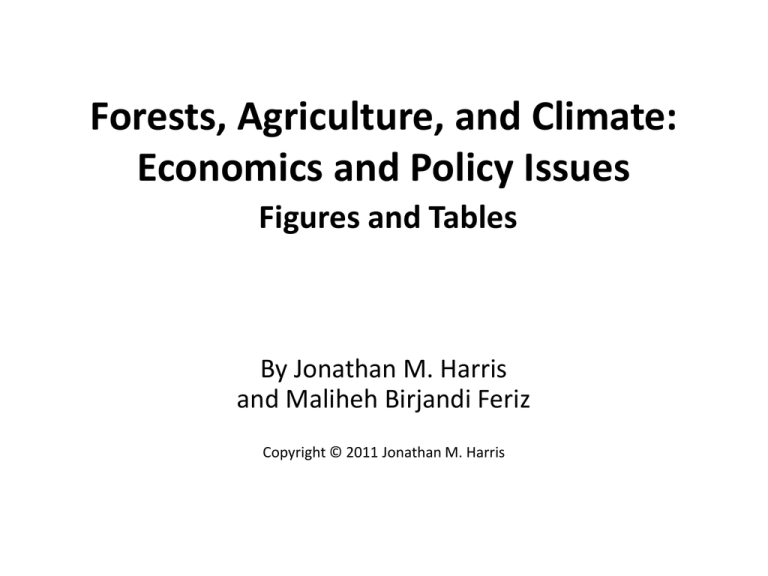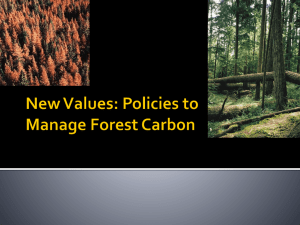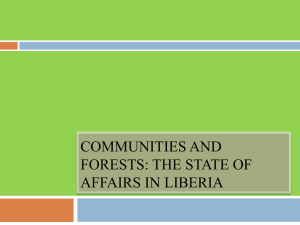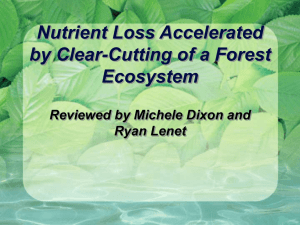PowerPoint file - Tufts University
advertisement

Forests, Agriculture, and Climate: Economics and Policy Issues Figures and Tables By Jonathan M. Harris and Maliheh Birjandi Feriz Copyright © 2011 Jonathan M. Harris Figure 1. Forestry and Agriculture as a Percent of Total Greenhouse Gas Emissions Fossil fuel supply 5% Waste 3% Building 8% Power Supply 21% Power Supply Industry Forestry Transport 13% Agriculture Transport Industry 19% Agriculture 14% Building Fossil fuel supply Waste Forestry 17% Source: Figure adapted from UN Framework Convention on Climate Change , UNFCCC 2007 Figure 2. Sources and Flows of Greenhouse Gases Figure source: World Resource Institute (WRI), can be accessed at http://cait.wri.org/figures.php?page=/World-FlowChart Figure 3. Designated Functions of Forests, 2010 Unknown 16% Other 7% Production 29% Production Protection of soil and water Conservation of biodiversity Social services Multiple use Other Multiple use 24% Unknown Conservation of biodiversity 12% Protection of soil and water 8% Social services 4% Source: Global Forest Resources Assessment, by Food and Agriculture Organization of the United Nations, FAO 2010 Figure 4. Forests as Carbon Stocks and Carbon Fluxes Source: CIFOR, World Agroforestry Centre and USAID 2009 Forest and climate change toolbox [PowerPoint presentation]. Available fromhttp://www.cifor.cgiar.org/fctoolbox/. Figure 5a. Annual Net Flux of Carbon to the Atmosphere from Land Use Change, South America, Africa, and Asia: 1850-2005 1000.0 800.0 Flux (Tg C/Year) 600.0 S+C America 400.0 Trop.Africa S+SE Asia 200.0 1850 1856 1862 1868 1874 1880 1886 1892 1898 1904 1910 1916 1922 1928 1934 1940 1946 1952 1958 1964 1970 1976 1982 1988 1994 2000 0.0 -200.0 Year Source: Houghton, R. A. 2008. “Carbon flux to the atmosphere from land-use changes: 1850-2005”. Oak Ridge National Laboratory, Data are accessible at http://cdiac.ornl.gov/trends/landuse/houghton/houghton.html Figure 5b. Annual Net Flux of Carbon to the Atmosphere from Land Use Change, Europe, China, Former USSR, and USA: 1850-2005 1000.0 800.0 Flux (Tg C/Year) 600.0 Europe 400.0 China Frmr USSR USA 200.0 1850 1856 1862 1868 1874 1880 1886 1892 1898 1904 1910 1916 1922 1928 1934 1940 1946 1952 1958 1964 1970 1976 1982 1988 1994 2000 0.0 -200.0 Year Houghton, R. A. 2008. “Carbon flux to the atmosphere from land-use changes: 1850-2005”. Oak Ridge National Laboratory, Data are accessible at http://cdiac.ornl.gov/trends/landuse/houghton/houghton.html Social and Ecological Functions of Forests Tropical forests, Cambodia Unsustainable timber harvest Traditional forest use Mangrove forests, Thailand Shrimp farming Intact ecosystem Tropical forests, Cameroon Farming 0 500 1000 1500 2000 2500 Sustainable forestry 3000 3500 4000 Value in dollars per hectare Source: Costanza, R., et. Al., 1997, “The value of the world's ecosystem services and natural capital” Nature 387. Figure 6. Top Countries with the Largest Forest Area Source: Global Forest Resources Assessment, by Food and Agriculture Organization of the United Nations, FAO 2010 Figure 7. The World's Forest Coverage Source: Global Forest Resources Assessment, by Food and Agriculture Organization of the United Nations, FAO 2010 Figure 8. Annual Change in Forest Area by Region, 1990-2010 Source: Global Forest Resources Assessment, by Food and Agriculture Organization of the United Nations, FAO 2010 Figure 9. Annual Change in Forest Area by Country, 2005- 2010 Source: Global Forest Resources Assessment, by Food and Agriculture Organization of the United Nations, FAO 2010 Figure 10. Causes of Forest Decline Causes of Forest Decline Direct Natural Causes • Hurricanes • Natural fires • Pests • Flood Resulting from human activity • Agricultural expansion • Cattle ranching • Logging • Mining and oil extraction • Construction of dams • Roads … Agents • Slash and burn farmers • Agribusiness • Cattle ranchers • Miners • Oil corporations • Loggers • Non timber commercial corporations Underlying Market Failure • Unpriced forest goods and services • Monopolies and Monopsonistic forces Mistaken Policy Interventions • Wrong incentives • Regulatory mechanisms • Government investment Governance Weaknesses • Concentration of land ownership • Weak or non-existing land ownership and land tenure arrangements • Illegal activities and corruption Broader Socio-economic and political causes • Population growth and density • Economic growth • Distribution of economic and political power • Excessive consumption • Toxification • Global warming • War… Source: Contreras- Hermosilla, A. 2000. The underlying causes of forest decline, Citeseer Figure 11. Regional Breakdown of Drivers of Deforestation Source: Project Catalyst 2009 Towards the inclusion of forest-based mitigation in a global climate agreement (Working Draft), accessible at: http://www.projectcatalyst.info/Publications/Working%20Group%20papers/Towards%20the%20inclusion%20of%20forestbased%20mitigation%20in%20a%20global%20climate%20agreement%2014%20May%2009..pdf Graph Source: Rhett A. Butler / mongabay.com, http://www.mongabay.com/ Figure 12. Annual REDD Economic Mitigation Potential, 2030 Source: IPCC Fourth Assessment Report: Climate Change 2007, Accessible at http://www.ipcc.ch/publications_and_data/ar4/wg3/en/ch9s9-4-4.html Table 1: Potential for Carbon Emissions Reduction in Forested Lands Fraction of total (technical) potential in Economic potential in 2040 (MtCO2/yr) low Economic potential in 2040 (MtCO2/yr) high cost class <20 US$/tCO2 North America 400 820 0.2 Europe 90 180 0.2 Russian Federation 150 300 0.3 Africa 300 875 0.6 OECD Pacific 85 255 0.35 Caribbean, Central and South America 500 1750 0.6 Non Annex I East Asia 150 400 0.3 Non Annex I South Asia 300 875 0.6 1,975 5,455 Total Source: Metz et al. 2007a, available at http://www.ipcc.ch/publications_and_data/ar4/wg3/en/ch9s9-4-4.html#table-9-6 Current carbon stocks for the Pan-Amazon and Brazilian Amazon (left bar); estimates of cumulative emission by 2050 under BAU (business-as-usual) and governance scenarios. Sources: Sathaye et al. 2006, Soares-Filho et al. 2006, 520-523and IPCC Fourth Assessment Report: Climate Change 2007, accessible at http://www.ipcc.ch/publications_and_data/ar4/wg3/en/ch9s9-4-3-1.html Figure 13. REDD supply curve Price [$/tCO2] Quantity [MMtCO2/Year] Source: Adapted from Estimating the Costs of Reducing Forest Emissions by Wertz-Kanounnikoff , 2008 Figure 14. Supply curves from global models 100 90 90 80 80 70 70 60 60 Carbon Price [$ /tCO2] Carbon Price [$ /tCO2] 100 50 40 30 20 10 50 40 30 20 10 1000 2000 3000 4000 5000 1000 3000 4000 5000 Emission reduction from AD [Mt CO2/yr] Emission reduction from AD [Mt CO2/yr] Supply curves in 2010 REDD cost: $20/tCO2 can abate on average 3000 Mt CO2/Yr 2000 Supply curves in 2030 REDD becomes more expensive: $20/tCO2 can abate on average 2200 Mt CO2/Yr Source: Adapted from Kindermann et al. 2008 and Wertz- Kanounnikoff 2008 Figure 15. Illustration of Baseline Credit System Forest Emissions Historical level carried forward Baseline Credits awarded on the basis of difference between baseline and actual Actual Time Source: Adapted from Eliasch Review, 2008 Price Price Price Figure 16. Market Phenomenon Causing Leakage P1 P0 Quantity of timber Internal response Withdrawal (a) Country A supply: Reduces deforestation and commodity supply Quantity of timber External response Quantity of timbe Net supply response Withdrawal (b) Country B supply: Increases deforestation and commodity supply (c) Global market: Net effect of country A and B responses Murray, B. C. 2008. Leakage from an avoided deforestation compensation policy: Concepts, empirical evidence, and corrective policy options. Nicholas Institute for Environmental Policy Solutions, Duke University, Durham, NC Gain-loss approach vs. Stock-difference approach 2. Gain- loss approach C Uptake via growth 1. Stock- difference approach Carbon stock in year 1 Carbon stock in year 2 Disturbance Source: Adapted from Wertz-Kanounnikoff et al. 2008 Land use type Harvest Figure 17. Global Greenhouse Gas Emissions from Agriculture Source: World Resource Institute (WRI), accessed 2011 Figure 18. Agricultural Greenhouse Gas Emissions by Region Projected to 2020: Developed Nations GHG emissions in Agriculture (Mt CO2eq./yr) 2000 OECD NA W Eur 1000 FSU C&U Eur OECD Pac 0 1990 1995 2000 2005 2010 2015 2020 Source: Smith et al. 2007, 6-28. Note: ME&NA: Middle East and North Africa; SS Africa: Sub-Saharan Africa; S. Asia: developing countries of South Asia; LA&C: Latin America and The Caribbean; E Asia: developing countries of East Asia; OECD Pac: OECD countries of the Pacific Region; C&E Eur: Central and Eastern Europe; FSU: Former Soviet Union; W Eur: Western Europe; OECD NA, OECD countries of North America Figure 18. Agricultural Greenhouse Gas Emissions by Region, Projected to 2020: Developing Nations GHG emissions in Agriculture (Mt CO2eq./yr) 6000 5000 4000 ME&NA SSAfrica 3000 S Asia LA&C E Asia 2000 1000 0 1990 1995 2000 2005 2010 2015 2020 Source: Smith et al. 2007, 6-28. Note: ME&NA: Middle East and North Africa; SS Africa: Sub-Saharan Africa; S. Asia: developing countries of South Asia; LA&C: Latin America and The Caribbean; E Asia: developing countries of East Asia; OECD Pac: OECD countries of the Pacific Region; C&E Eur: Central and Eastern Europe; FSU: Former Soviet Union; W Eur: Western Europe; OECD NA, OECD countries of North America Figure 19. Global GHG Mitigation Potential from Agriculture 1600 GHG Emission Potential- Mt CO2-eq/yr 1400 1200 1000 800 600 N2O CH4 400 CO2 200 0 -200 Source: Adapted from Metz et al. 2007a and Smith et al. 2008, available at http://www.ipcc.ch/graphics/ar4-wg3/jpg/fig-8-4.jpg Figure 20: Global Mitigation Potential from Agriculture by CO2 price 1400 Mitigation Potential (Mt CO2-eq. yr−1) 1200 1000 800 Up to 20 US$/tCO2-eq 600 Up to 50 US$/tCO2-eq Up to 100 US$/tCO2-eq 400 200 0 Restore Cropland Grazing land Restore Rice cultivated management management degraded management organic soil land Livestock Set-aside, Manure LUC & management agroforestry Source: Adapted from (Metz et al. 2007a) and (Smith et al. 2008), available at http://www.ipcc.ch/graphics/ar4-wg3/jpg/fig-8-9.jpg Figure 21: Global Biofuel Production Source: World Bank, World Development Report 2008, Biofuels: the promise and the risks, available at http://siteresources.worldbank.org/INTWDR2008/Resources/2795087-1191440805557/42491011191956789635/Brief_BiofuelPrmsRisk_web.pdf Figure 22: Renewable Energy and Traditional Biomass Source: WorldWatch Institute, 2007 and UNEP, Towards sustainable production and use of resources: Assessing biofuels, 2009 Figure 23. Trends in Biofuel Production, 1975-2007 1200 1000 Peta Joules 800 600 Ethanol Biodiesel Equiv. 400 200 0 Source: Adapted from UNEP, Towards sustainable production and use of resources: Assessing Biofuels, 2009; and SCOPE International Biofuels Project 2009, available at http://www.eeb.cornell.edu/howarth/SCOPEBiofuels_home.html Figure 24. Greenhouse Gas Savings of Biofuels Compared to Fossil Fuels Source: UNEP, Towards sustainable production and use of resources: Assessing biofuels ,2009









